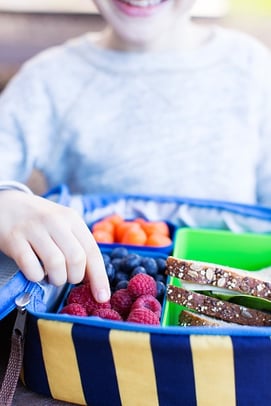 It’s that time of year again…back to school! This means busy evenings or early mornings getting lunches packed for the kids. What’s in a child’s lunch is important because it’s in childhood that eating habits are formed—and heart disease, obesity, osteoporosis, and other diseases begin to develop. Fatty buildups, the beginnings of clogged arteries, are seen in the arteries of children as young as 10 years old.
It’s that time of year again…back to school! This means busy evenings or early mornings getting lunches packed for the kids. What’s in a child’s lunch is important because it’s in childhood that eating habits are formed—and heart disease, obesity, osteoporosis, and other diseases begin to develop. Fatty buildups, the beginnings of clogged arteries, are seen in the arteries of children as young as 10 years old.
So even though that prepackaged meal is the quickest and easiest thing to throw in a lunchbox, consider these 10 ways to help your child eat a more balanced lunch.
- Encourage your child to choose 1% or fat-free milk. Milk is the biggest source of saturated fat in children’s diets. Choosing 1% or fat-free milk instead of whole or 2% is an important strategy for keeping children’s hearts healthy and arteries clear.
- Switch from bologna, salami, pastrami or corned beef, and other fatty luncheon meats to low-fat alternatives. Supermarkets sell many good-tasting, low-fat or fat-free brands of turkey breast, chicken breast, ham, bologna, and roast beef.
- Include at least one serving of fruit in every lunch. Try buying a few new types of fruit each week to let your child discover new favorites and to give him or her more healthy eating choices. In addition to apples, oranges, or bananas, try pears, sliced melon, cups of applesauce, grapes, or pineapple (fresh or canned in its own juice). Try serving fruit in different ways: whole, cut into slices, cubed, or with a yogurt dipping sauce.
- Sneak vegetables onto sandwiches. Try lettuce, slices of cucumber, tomato, green pepper, roasted peppers, zucchini, or sugar-snap peas. Eating fruits and vegetables reduces your child’s chances of heart disease, cancer, blindness, and stroke later in life. Putting veggies on a sandwich is one way to get more into your child’s diet.
- Use whole-wheat bread instead of white bread for sandwiches. Choose breads that list “whole wheat” as the first ingredient. If the main flour listed on the label is “wheat” or “unbleached wheat flour,” the product is not whole grain. Most multi-grain, rye, oatmeal, and pumpernickel breads in the U.S. are not whole grain.
- Limit cookies, snack cakes, doughnuts, brownies, and other sweet baked goods. Sweet baked goods are the second leading source of sugar and the fourth leading source of saturated fat in Americans’ diets. Low-fat baked goods can help cut heart-damaging saturated fat from your child’s diet, but even fat-free sweets can crowd out healthier foods like fruit. This nutrition rule does say LIMIT and not eliminate. The key is moderation when it comes to sweets!
- Pack baked chips, pretzels, Cheerios, breadsticks, or low-fat crackers instead of potato, corn, tortilla, or other chips made with oil. Avoid empty calories from artery clogging fried chips. Also, beware of Bugles, which are fried in heavily saturated coconut oil. One ounce has as much artery-clogging fat as a McDonald’s Quarter Pounder.
- If you pack juice, make sure it’s 100% juice. All fruit drinks are required to list the “% juice” on the label. Watch out for juice drinks like Sunny Delight, Hi-C, Hawaiian Punch, and Capri Sun. With no more than 10% juice, they are just as sugary as soft drinks.
- Don’t send prepackaged lunch trays. Oscar Mayer’s Lunchables that come with a treat and a drink get two-thirds of their calories from fat and sugar. They also contain over 1000mg of sodium, which is half the recommendation for the whole day. Making your own healthy alternative is as easy as packing low-fat crackers, low-fat lunchmeat, a piece of fruit, and a box of 100% juice in your child’s lunchbox.
- Let your child help pack their lunch. If your child is excited about the foods they are eating, they will be more likely to finish their energy-packed lunch. Allow them to help pick and choose items to put in their lunchbox each night or morning, teaching them the importance of meal planning and responsibility.
This blog was written by Angie Mitchell, RD, Wellness Coordinator. To find out more about the NIFS bloggers, click here. (And to see what she brings for her lunch, click here!)

